The Sights Of Furnas
In Furnas (furnash) we are staying in the 4 star hotel that is associated with one of the beautiful private gardens in town. The grounds have a large (football field sized) Natural Mineral Hot-tub (more on this later) several historic buildings (the original plantation houses) as well as a large private garden organized into different plant type areas. We are going to take a tour of the gardens (lead by the current head gardener's daughter) and also walk around town some to see the local sights. Oh Oh, and we just have to jump into that huge hot tub.
The Garden -
Our tour guide was raised in the gardens (her father, the head gardener, lives in a nice house on the grounds). She took us for a walking tour and explained how the different gardens came to be and the idea of them. She had had a hand in the design of the many of the little areas. She explained some of the history. As with many of the large mansions around, this one started out as a private residence exploiting the wealth of the Orange growing times in the Azores. During that time is was popular to have big gardens with exotic plants. Now that this one is a internationally famous garden, people will send them (or trade them) rare exotics and they set up areas to grow them.
They have one little enclosed area they have built up to grow tree ferns. These plants don’t usually do so well in the climate of Furnash, but the gardeners have built a little micro climate area and they now have a number of these plants that are flourishing.
 |
| Tree Fern Area. Note hedge to keep out wind |
There was one area with these old cement sculptures of animals that had been planted with a vine that grow all over it making a sort of chia-pet-like garden area. Our guide was a little amused by this area, “Oh, my father decided to try and be a sculptor for a few years and he made these things and planted them here with these nice growing vines. Then he got tired of the idea and moved on to other things”. They look like they have been there forever.
The town river runs through the property and there are also accesses to some of the hot springs. A major flow of hot water comes from a few blocks away (through pipes) and goes into the large pool that is used for soaking. People come from all over to walk-in to the garden and use this huge brown water hot tub. Ten Euros to get in. Be careful what you wear as anything will be dyed brown by the mineral rich hot water. We will take a dip later, but right now we must finish our tour.
There is a large square (but shallow) pool down by the river. Maybe 5 meters by 15. Our guide says that later in the summer there will be giant pond lily pads growing there. They can only grow in this climate because the cement wall around the pond is heated with flowing hot water (probably the same water that goes to the soaking pool) and that keeps the pond warm enough for the lilies. I love it when old technology is used like this. I like the idea that people from older (even ancient) times show that they are every bit as intelligent and inventive as modern people, they just have a different set of technology tools.

Cozido das Furnas

 |
| serving up Cozido das Furnas |
One of the objectives of our morning hike around Lago de Furnas was to stop at the thermal hot spot on the North East side of the lake and view the traditional ‘removal of lunch’. The local people have a traditional meal and cooking method that requires the food to be placed in a container (now stainless steel) and then buried in the hot grounds of this thermal area. There is rope around the various hot spots and in some there is boiling water coming out of the ground, like the thermal springs in town. They choose the place to bury the food according to how they want to cook it; different spots are at different temperatures. There is one area that the hotels and restaurants use (for big pots?), one area where the locals use (for a small fee) and another area that is slightly hotter where you do faster cooking. As it is, our meal was put into the ground around 6:00 this morning and it is important that we get to the hot springs right at 12:30 when they are going to start pulling things out.
There are evidently cement pipes buried in the hot sand (a new contrivance) and the large metal pots are lowered in by 2 men with metal grabber tools and then covered with the hot sand. We saw them clear the (steaming) sand off of the top and then take off the wooden lid and reach in with the grabbers and lift out the pot. So exciting. This area is evidently just under 100C in temperature. So things cook but they don’t boil.
When we got back to our hotel, they served us this traditional meal. They give you a reasonable sized piece of each thing in there, which is beef, pork, chicken, more pork, potato, sweet potato, tarot, and something else. A LOT of food. I thought it was delicious.
Some sights around town
Some cool things to see when you are just strolling around the little town. The river that runs through the town is not hot, but it is loaded with minerals. Along the banks of the river through much of the town, tarot fields are planted. Tarot requires a lot of water and these plants (at least when we were there) were pretty mature and were constantly flooded with water directly from the river. Little stone diversion canals were made up stream from the fields that carried water around the perimeter of the fields to then allow the water to flow back into the field and then back into the river. What a simple and effective way to irrigate.
Lots of tourist shops and old buildings around town. Good place to get your kitsch. I am very wary of buying souvenirs in shops these days. It seems like all of the cheap knick knacks are actually made in China. I want locally sourced cheap Knick Knacks. Is that so strange? I was looking for some locally made white and blue tiles. Never did find any that I was sure about.

With all of these cows around one would expect to be able to find some really good ice cream. You can do, but I find it is easy to fall into the trap of going out of your way to find ice cream that someone else thinks is good but you really don’t. We got sent to one place that was billed to us as having really great ice cream that was made from special milk that was from cows that had special DNA such that people that were lactose intolerant could indeed tolerate this product. Not sure exactly what that meant. Anyway, we found our way to the store only to find that the ice cream there was soft serve. Now, soft serve can be great, but I guess I expect to find it at a county fair or the dairy queen and not at a “Place that has Great Ice cream”. Maybe it wasn’t great but just lactose friendly.



Public Springs -
There are little springs all over the place. Just a wall on the side of the road where there is a little fountain with water coming out of a pipe in the wall. Sometimes you need to go down a few steps to reach the fountains. Often there is a tile sign with the fountain name and the picture of a saint on it. Different fountains are said to have different properties and/or healing effects. If I come back again, I will want to do a special tour where I go around and sample all of the various waters.
 |
| The foot soak place |

The Brown Hot Tub
The hot springs at our hotel (The Terra Nostra) is a big local attraction. It is a HUGE pool. Perhaps 50 meters square. It is almost 2 meters deep. It is continuously fed by volcanic waters that gushes out of 2 large pipes at a constant temperature of 40C (104F). The water is a very dark brown with minerals (sulphur etc). I held my hand under and it disappeared from view at around 10cm.
Isn’t metric fun? I am thinking that at least half of my audience has no internal map that tells them how long 10cm is. Don’t worry, I don’t know either. Let’s say 6 inches.
When we first saw the pool, we were unsure if we really wanted to go in. There were lots of people in it because the pool and gardens are open to the public until 16:30. We decided we would come back after 17:00 and before our dinner. What a great decision. The water is really nice. It is deep and hot and feels great. Standing under the pressure of the big fountains that are supplying the water is just something you can’t do anywhere else. The water is Pouring Out so fast and abundantly and it is so hot! (it won’t burn you, but it feels very hot at first). Please note that the entire big tub is hot. The water is not recycled. Hot water comes in from the Volcano, slightly less hot water drains out the other side and goes back down (presumably to the river).
The hotel gives you special gray towels and robes to use when you are in the pool as the brown water will stain your clothing. It took a good 5 minutes to rinse the brown water out of my swimsuit when we got back to the room. Our guide told us about a guy that had a white beard and ended up with the ends dyed brown for a few days. Ha. But it was really nice. We went back again the next day and got caught in a glorious heavy downpour of rain. Cold heavy rain whilst standing in a deep hot mineral springs; such fun.
After our long soak both Paiger and I noticed that we had sort of a metallic aftertaste in our mouths for a couple of hours. I am assuming this was from absorbing minerals through our skin. Now that is interesting. I guess it must be good for you or people would have been dropping dead for years and surely someone would have noticed, not matter how murky the spring waters might be.
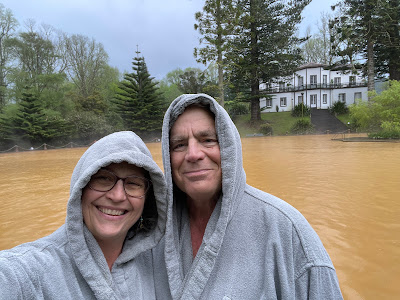 |
| The Grey Robes. You know, if you put your room key in your robe pocket and everyone has robes just like yours... and keys just like yours. |
The Abandoned Village – Sanguinho
Today we did our last hike that was billed as a big climb and a somewhat treacherous descent down a steep cobblestone pike. (There is a really dirty limerick hidden in there for my fellow Rugby players). There was a reward of a truly awesome “Proper” waterfall. We will also be visiting the site of an abandoned old village.
The hike wasn’t that bad, though everyone, including the guide, did use trekking poles. We started in this very nice little town (population around 300) and walked up the road till we got to the state maintained hiking trails. There are a lot of trails all over the Acores and they tend to be marked with these sign posts that have double stripes on them, usually yellow and red. The pattern of the yellow and red tells you which way to turn or to not proceed and the poles (either wood or cement or stone) will often have distance in kilometers. (What do you say instead of mileage?)(No, really, what DO you say instead of mileage? Meterage?).

Sao Miguel has had a lot of rain recently so there was a lot of mud and slippery rock down by the river we were ascending. Down under the trees. There were some tricky places and we had some people slip and do a soft sit down on the banks, but nothing major. Our oldest hiker is 88 and damn if she did just climb right up the mountain. And she is always looking so dapper in her nice slacks and matching shirt. She dresses nicer to hike than I do to go to dinner. Everyone on the hike seeks to emulate her.
Speaking of people on the hike, when we having our last breakfast at the hotel in Ponta Delgada, there was another Road Scholar group just fresh in from the flight from Boston. So these guys had been flying through the night and were now having their first breakfast on the island before checking into their rooms. They were not on a hiking tour but a bus tour. Looking at them I noted that they were a lot heftier than the average person in our group. In fact, I think I am the heaviest person in our group and I would have been perhaps the lightest person in their group. The message I am getting from this is that I want to be hiking when I am 88, I best lose a bit more weight and keep doing the high adventure (for old people) tours.
So we hike up some steep steps and such until we are accosted by a herd of wild chickens. Then we took the side trail off to the waterfall. It was a nice waterfall and all. I guess it was ‘Proper’ in the sense that it flows like this all year and doesn’t depend on the recent rain. Personally I thought the waterfall from the generator hike was more impressive. Be that as it may, a waterfall. So here we are hiking through the jungle up high in the hills and I note that there is an old stone fence built up running above us. Even some of the trail is paved in stones. Why is that? I asked our guide, Pedro. He said that all of this land was once agricultural. Even up here in the mountains with no power or good roads. Well, perhaps in a time before power and the need for good roads. He said when it because more economical to import food from the mainland or perhaps to grow it in the flatlands the farmers abandoned this area. The land itself is still mainly private. He said that the government does not appropriate abandoned land.
We hike along the ridge for a while and then run into a maintained field of crops. Some Coffee. Perhaps some tea. This is the start of the abandoned village.
In 1957, there was an eruption of the volcano on the island of Fayal. The entire island had to be evacuated. The USA, because of its close ties with the Acores, passed an immigration bill that allowed the peoples of Fayal to immigrate to the US with their families. This was a very popular action but didn’t really impact that many people as the population of Fayal was small (and they didn’t all immigrate). Later, the US congress extended the bill to allow all peoples of the Acores to immigrate. That put pressure on this village. It was very high up in the hills, somewhat difficult to get to and lacking in modern facilities. I am sure that some of the people had decided to immigrate to the US, leaving behind their empty houses. Down at the coast, people also left leaving empty houses. The property values must have really plummeted. Why stay up in the hill in a half empty village when you could get a decent house down by the shore? So everyone just left.

As you walk through the village there is a very mixed sense of time. On the one side, some of these structures look like they have been abandoned for a centuries, on the other, you see a little metal door with an aluminum latch leading to a water shut-off valve. Clearly modern. Of course, the foundations for some or all of these buildings may be a few centuries old and then had more modern facilities tied in over time. Also, the jungle if very fast growing and aggressive in this region. Moss and grasses will grow on the roof and the walkways in a year or so. Trees will take over even inside the houses in a decade or so. And it has been half a century since the occupants left. I looked into unit 13, it was abandoned but still had most of its roof. There was a lot of debris inside, unclear if it was stuff that had been left behind or places where people had squatted or camped for a night or two.
A rich German lady came upon this place a few years ago and decided to spend her money to restore it to traditional conditions. She had electricity piped in and began acquiring the structures and then repairing them. There are accommodations there now, but she doesn’t use the place as a money making venture so it is unclear how you acquire the right to stay there. She is still trying to buy the rest of the little town, but it is hard to do this as it isn’t always easy to track down the current owners. In the Acores, the land does not revert to the government if abandoned. Someone owns this land, They may be 2nd or 3rd generation Americans by now and unaware of their ownership. I think in the US, the government would have claimed the land for back taxes after 50 years.
.jpeg) |
| Serious Jon Not Grouchy Jon |
The town has an adorable little cobblestone road/trail that winds up to it from the village below. It is very picturesque but can be a little dangerous to walk down if it is wet. Well worn cobbles are really slippery once you get some water on them. We were lucky that they were dry for us. I was tooling down them using my trekking poles and felt that I was doing fine until I looked up from my walking and saw the rest of the group Way down in the valley looking up at me and wondering what was taking me so long. I have an artificial knee, Dammit !! Someone took a picture of me going down the hill, man do I look fat tired and angry. I remember going down the hill and thinking about my emotional state. I was thinking that I was having fun, but concentrating very hard on going the maximum safe Jon speed down the hill. I was thinking that I probably had a very serious look on my face. Boy Howdy!!
And now you are thinking: OK, but what was the limerick?
It starts out: “There once was a girl from Hoboken”. Nuff Said.
Domo Obrigado Mr Roboto –
To say thank you in Portuguese you say Obrigado (if you are a man, Obrigada if a woman). To say thank you in Japanese you may say Arigato. They sound so much alike if you say them together real fast: Obrigado, Arigato. Gado, Gato. What a coincidence! Except when I pointed this out to my guide (and my grandson) he said that it wasn’t a coincidence (not that my Guide was my grandson). He (the guide) said that the Japanese had borrowed this word from Portuguese sailors who were trading with the southern ports in Japan. Anyone that has read “Shogun” knows about the trading port in Nagasaki and the Portuguese and Spanish ships bringing in the silk from China to trade for Japanese silver. You also learned that the Spanish and Portuguese didn’t like each other very much and liked the Dutch and the English even less. But never mind that. My grandson (who lives in Ponta Delgada but is not my guide), who is speaking Portugese in school, says it was the opposite. He says the Portuguese heard Arigato in japan and thought it sound like Obrigado (which means “I am obligated to you”) and adopted that form. I am betting I can get a third opinion on the internets. I am betting on ‘It is just a coincidence and both forms existed before the two peoples were in contact”.
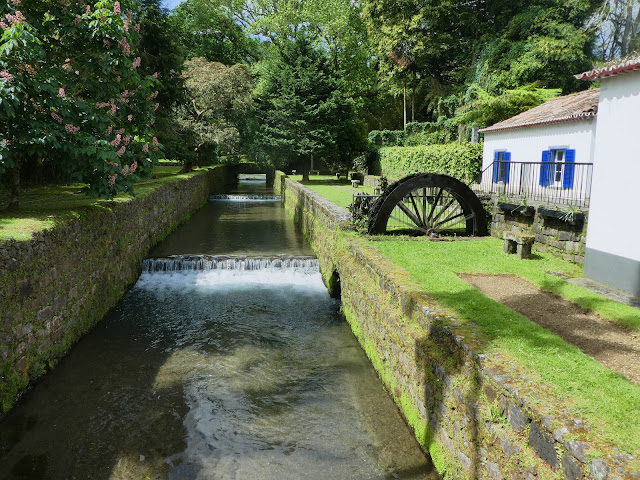
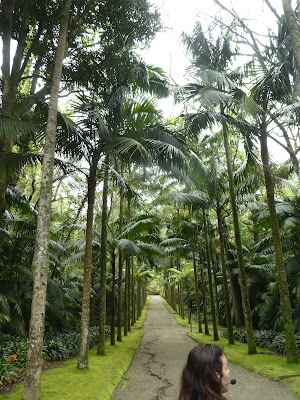






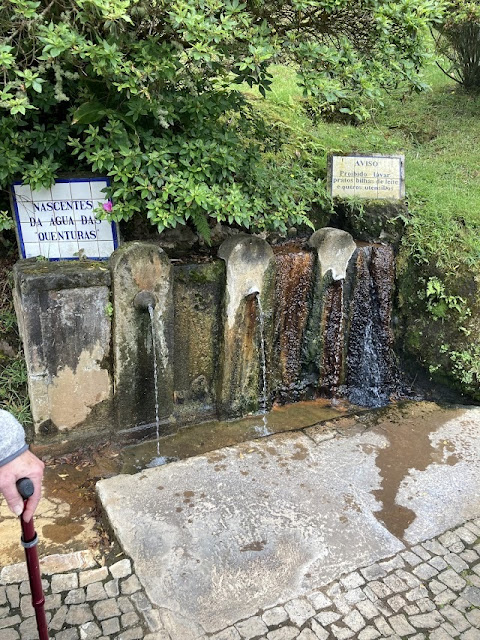




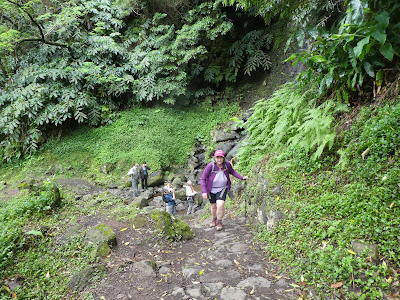









No comments:
Post a Comment